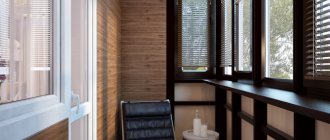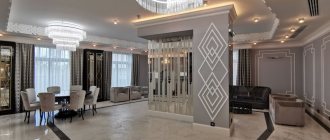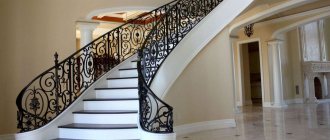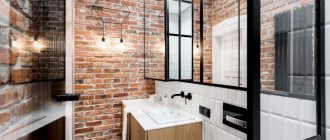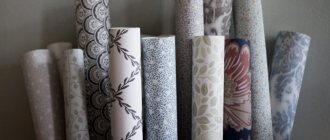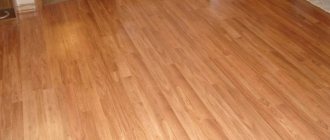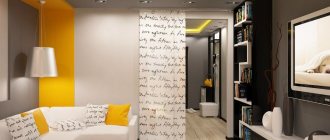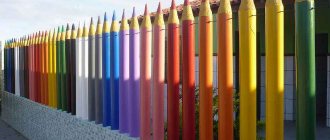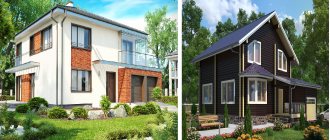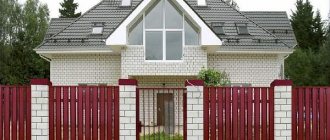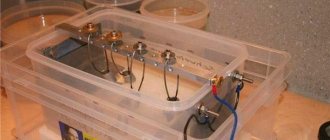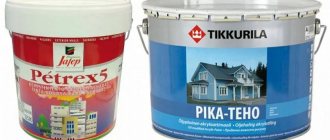Rednasty
27650 0 6
Rednasty November 2, 2016I'm not a wizard, I'm just learning. But I know everything about interior styles, comfortable home improvement and the transformation of Khrushchev’s apartments into luxury apartments. Hobbies: I like to give good advice.
The dacha is a truly cozy place where you want to return again and again!
In our realities, large investments in dacha repairs look quite unproductive. On the one hand, is it worth spending a lot on furnishing a home in which we spend at most several months? On the other hand, no one can cancel the completely reasonable desire for a cozy place in their “country estate”.
Decorating a country house can look simple and neat
If you are interested in simple materials and budget solutions that can improve and decorate your dacha, then this article is definitely for you. In it, I will analyze the main inexpensive methods of wall cladding and share several creative options for creating an original country interior.
Lining
Another natural and budget material for finishing a country house interior.
It will fit perfectly into country style and will withstand temperature changes and humidity. The lining becomes wear-resistant and rot-resistant after applying special compounds. It can be installed on slightly convex or curved walls. The material can be painted, treated with stain, wax or oil, giving the desired natural shade. A more budget-friendly option is varnish, but over time it turns yellow. The layout of the elements can be any: diamond, herringbone, half wall. With the help of lining they decorate the ceiling or highlight certain zones.
Start of the process
Finishing is possible after the end of the active stage of shrinkage. This rule applies to a new, newly built house. If you have to process an old structure, you can start immediately. It is important to consider the following:
- If the base of the house is a log and ordinary timber, then ideally the finishing starts no earlier than a year.
- If the base of the house is dry profiled or laminated veneer lumber, you can start in 1-2 months.
It is necessary to take into account climatic features, average temperature, humidity indicators. Finishing the interior of walls made of logs and ordinary timber is allowed after caulking is completed.
The work involves two stages:
- First, the caulking process is carried out several weeks after the walls are assembled.
- The second part begins at least 6 months later - after shrinkage.
To caulk walls, you need a material with heat-insulating and sealing properties. Tow and jute meet all the criteria for high quality. They are widespread due to their affordable cost, unpretentiousness, and durability. It also happens in practice that some people use moss as a material for caulking because... there were no more modern substitutes.
Work is carried out from the outside and inside at the same time; you need to start from the bottom. As soon as the crown is ready on one side, it is worth moving to the other side - this will help avoid distortion.
When the work is completed, the object will rise a few centimeters, but soon the inter-crown filler will become more dense and the original height will return. Drafts will practically not make themselves felt due to the tight fit of the timber or log; this will significantly increase the thermal insulation performance.
Caulking wooden walls is a special type of activity that involves its own technologies and nuances; you can find out more about this in the article. As soon as the second caulking is completed, you need to measure the height of the walls from time to time. If the data has not changed within a couple of months, it means that the shrinkage has ended and finishing can begin.
Board
Suitable for both wall decoration and floor covering. The main difficulty is to choose the right material: the boards should not be wet and, conversely, overdried. They look impressive after treatment with protective compounds, give a country house a special charm and fill the atmosphere with coziness.
For dacha floors, there are special boards that are laid using the tongue-and-groove technology. This is the most reliable connection that allows you to create a strong and even floor.
Brushed and barn boards are still in fashion, but despite its aged appearance, the finished material is quite expensive. To avoid costs, the elements can be processed yourself.
Step-by-step finishing instructions
The finishing of the second floor at the dacha can be done with eurolining. For this, it is best to use the lightest breeds, which include:
- ash;
- spruce;
- maple;
- fir.
This will increase the space on the second floor. The work will require slats, the width of which ranges from 5 to 15 cm. Before finishing the second floor in the dacha, you will need to fill a wall frame, between the elements of which a distance of 50 cm is maintained. When finishing the attic with clapboard, the cladding is fastened with small nails. The surface is covered with a protective layer, which can be mastic, stain or varnish.
When considering options for finishing the attic, you may want to make the dacha less monotonous. To brighten up the interior, you can use MDF panels, which will add harmony to the interior, and also make the walls and ceiling durable and warm. If desired, the floor can be covered with laminate, and the walls can be decorated with MDF panels coated with cork. Wooden baseboards will complement the attic.
The attic floor room in the ceiling area can be supplemented with beams, which will give the interior a unique and rustic flavor. A small attic can be lined with plywood from the inside. But if the room has high humidity, you should avoid using this material. But if the space is heated, you can also paste wallpaper. When decorating a dacha, you can give preference to cheap finishing materials, for example, paper.
Logs or block house
If the walls of a country house are built from logs, try not to hide the authentic beauty of the wooden walls. Logs are a surprisingly durable and reliable material, and after repair they will last for decades.
House panels are used to decoratively imitate log walls. From the outside, they have a semi-cylindrical shape and are fastened with a tongue-and-groove locking connection. A block house made of wood is used for the interior, and vinyl is used for the façade cladding.
Why sheathe a house?
In addition to the decorative function, the outer cladding of the house also performs the following tasks:
- Reduces heat loss, and therefore energy consumption. Heating your home will be cheaper during the cold season.
- Repels rodents from wooden building materials.
- Protects from moisture and precipitation.
- Extends the life of the building.
Glass wallpaper
If you are looking for a more conventional, but at the same time durable material for finishing walls, fiberglass wallpaper is an ideal option. They are often used to decorate public places because they are resistant to mechanical damage and are not afraid of high humidity, fire and ultraviolet radiation. They also protect the walls from insects and slightly level the surface.
By choosing such glass wallpaper instead of paper or non-woven wallpaper, you are investing in the future: updating the renovation will not be difficult, since the coating can be painted several times.
Features of wall panels
Wall panels offer a wide variety of design solutions, the ability to implement projects of any complexity. Perhaps this is one of the favorite options of designers, since it does not limit imagination. If we talk about finishing a wooden house using wall panels, then you need to correctly decide on the type:
- Leather.
- Plastic.
- Glass.
- MDF.
- Bamboo.
- Wood.
Each option has its own specifics, for example, if you choose glass, you should be especially careful and take precautions. In addition, the glass is massive, which means it has an impact on the supporting structure. If the wall fencing is miniature and thin, then it is better to abandon this option.
It is necessary to carefully follow the recommendations from the manufacturer; the cladding is attached either to a substrate connected to the sheathing, or directly to the sheathing. Before starting work, it is important to choose the optimal fastening method.
Decorative plaster
The material cannot be called the cheapest, but if you wish, it is not difficult to find affordable compositions. Plaster imitates a variety of textures (stone, wood, concrete), and is perfect for finishing even wet rooms.
It is resistant to mechanical stress and easily tolerates temperature changes, which is especially important for a country house. Fans of decorative plaster value it for its durability and ability to hide minor irregularities.
Ideal for creating an interior in eco, Provence, country, chalet styles.
Sheathing options
Today, the construction market offers many variations and a variety of materials that are ideal for finishing a country house. Among a fairly impressive list, you can choose something according to the preferences of the home owner and his financial capabilities.
Lining
Lining is rightfully considered one of the most popular materials used for arranging summer cottages. The advantages of the panels speak for themselves. This:
Natural and aesthetic material - a godsend for framing a country home
- their pleasant aesthetic appearance, allowing you to imitate a variety of textures;
- affordable price;
- high thermal insulation performance;
- ease of installation, which can be handled even without much experience in repair work;
- environmental friendliness of the material.
Interior decoration of a country house with clapboard is a great idea for those who value comfort and coziness above all else. By experimenting with textures and shades, owners have the chance to create a memorable interior without spending a fortune.
The lining will decorate not only the rooms, but also the facade of the house
What should you consider during the installation process?
- High-quality finishing is possible only when using wooden sheathing as a base.
- If you want to insulate the walls of your house, you can put mineral wool, glass wool or expanded polystyrene into the frame.
- Wooden slats for the base should be secured either with nails or self-tapping screws.
Without a frame, installation of lining panels will be incomplete
I also want to note that lining can be a very inexpensive and practical answer to the question of how to decorate a change house into a country house.
Change houses finished with clapboard
Drywall
Drywall is not much inferior to lining in popularity. This is a universal material used both for leveling walls or arranging interior partitions, and for decorating window slopes.
Drywall is universal, it can be used for cladding almost any surface
Instructions for installing drywall are as follows:
- The first step is to create a frame from metal or wooden slats. They are fixed to the wall with screws or self-tapping screws at a distance of 40-50 cm from each other.
Lathing for installing gypsum boards on the ceiling
- Afterwards, plasterboard slabs are attached to the frame. The joints between the sheets are sealed with putty and then primed.
Brief instructions for puttying gypsum board joints
- After about 6-8 hours (this is exactly how long it will take for the primer to dry), you can proceed to pasting or painting the walls.
Now you can decorate the room
Plywood
This is what fully corresponds to the famous phrase “cheap and cheerful.” If you are thinking about how to decorate the walls to make it as budget-friendly as possible, then plywood will come in handy. This material allows the walls to “breathe”, it has good water resistance (so it can be used for cladding a bathroom) and sound insulation.
Even plywood can look very interesting
In addition to such impressive advantages, I would like to add easy installation with your own hands, which can be handled by people who have never done repairs before. As a finishing touch, the plywood can either be painted with bright paint or covered with wallpaper.
Plywood trim? Why not!
Linoleum and laminate
These floor coverings require high-quality surface preparation. Most appropriate in houses designed for all-season use. For a country house, it is recommended to choose moisture-resistant laminate sheets that will withstand exposure to water and condensation.
If your choice falls on linoleum, it is wiser to purchase a commercial type, which is resistant to abrasion and protected from force. In a country house, flooring in natural shades will look harmonious.
One of the advantages of a country house is that in its setting you can embody the most unusual ideas. This is where you can feel at one with nature and escape from the worries of the city.
Thermal panels
Thermal panels are a material that performs two functions at once - cladding and external insulation of houses. A layer of decorative coating is applied to the thermal insulation layer at the factory. It looks like marble or natural stone, does not burn, and has low water absorption characteristics.
You can clad and insulate a house with one material at the same time using thermal panels
This finishing material is made from polystyrene foam, mineral wool or extruded polystyrene foam. Depending on the type of insulation, the installation method is selected: polystyrene foam and polystyrene foam are glued to the appropriate composition. The joints are closed with a special aluminum strip or rubbed with paste.
Panels for façade cladding based on mineral wool are mounted only on a special system of profiles, and the joints are also sealed.
A very attractive idea is to immediately insulate the house and cladding it. Excellent appearance, and the characteristics of this cladding are impressive. It’s just a pity that there is little operating experience and no reviews yet: it appeared only recently.
There are also clinker thermal panels. Clinker tiles are glued to the insulation. The material is not cheap, but the characteristics are impressive, as is the variety of finishes.
Another option for thermal panels is with clinker tiles
The choice of materials that can be used to cover a house at any time - winter or summer - is considerable. There are expensive options, and there are cheaper ones. In any case, in addition to cost, be sure to consider vapor permeability. Then you won’t have to deal with mold and dampness.
